Some gynecological and surgical diseases can cause the formation of adhesions. Most often this happens in the chronic course of ailments, when a woman does not seek help for a long time. Reproductive organs suffer first, even if the problem does not arise because of them. Not surprisingly, the monthly spikes have a different appearance and signs than normal.
What adhesions
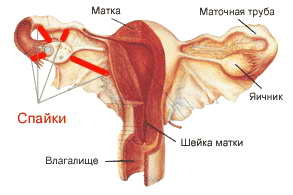
Normally cover internal organs, located in the abdominal cavity and small pelvis, smooth, mucous. This allows them to function without causing unpleasant sensations in a person, changing their position along with the whole body. With inflammation of the membrane of the organs change the structure, part is replaced by a connective tissue. The same happens after operations, when damaged cells are restored. On the surfaces and inside the organs, fibrin is formed, which has an uneven fibrous structure. And if one of them is inflamed or damaged, it is possible that when it comes into contact with the neighboring one, it can get stuck. And after a short time, both will be secured by sprouted vessels and cells of connective tissue. The same happens with different parts of one organ, for example, ovaries or fallopian tubes. Such spikes can be turned into monthly torment for a woman.
Cycle during adhesions
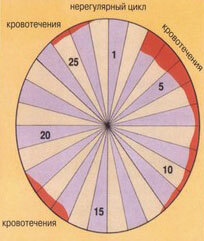
The menstrual cycle is very dependent on many factors that a woman can consider unworthy of attention: stress, diet, hypothermia. The appearance of abnormal proliferation of connective tissue, the formation of scars, the more it will affect it. Especially when the organs of the small pelvis are affected.
Spikes are the cause of delay in menstruation in frequent cases. If they are present in the uterine cavity, the endometrium is deprived of the ability to develop normally. Its growth begins with a new cycle, the largest thickness is in the middle of the period, and towards the end it again becomes thin, ready to tear itself away and be replaced by a new layer of healthy cells. Scar tissue is not capable of experiencing such changes. Moreover, it inhibits them in healthy cells.
When a long time is not monthly, spikes can also appear in the ovaries. They provide hormonal support for the cycle and menstruation. Connective tissue interferes with the production of FSH and LH, inhibits the production of estrogens and progesterone, which prevents not only the development of the endometrium, but also ovulation. Doubts about whether spikes can cause a delay in menstruation, in the circumstances, experts do not arise.
The nature of menstruation and adhesion
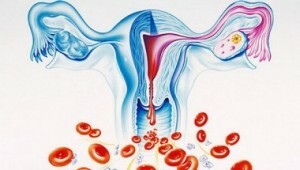 Changes in menstruation can have a different character, which depends on both the characteristics of the organism and the localization of the process. A woman may notice that on critical days, there is significantly more excreta and come faster than before. But spikes and meager months are the most frequent combination. If they are located in the uterus, the area of the cell layer that is rejected during menstruation is markedly reduced. This can not but affect the composition and amount of excreta. They are made scarce, they do not last long.
Changes in menstruation can have a different character, which depends on both the characteristics of the organism and the localization of the process. A woman may notice that on critical days, there is significantly more excreta and come faster than before. But spikes and meager months are the most frequent combination. If they are located in the uterus, the area of the cell layer that is rejected during menstruation is markedly reduced. This can not but affect the composition and amount of excreta. They are made scarce, they do not last long.
If the uterus is connected to the outer surface with other organs, this limits its contractility, which can make menstruation longer than ever. Despite the scarcity of excreta, in this case they last longer than 7 days.
Menstruation for changes in the ovaries
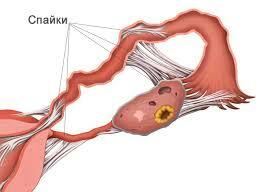
If it is determined that a woman has ovarian adhesions, can they affect the monthly ovaries, the main thing that interests her. In this case, the process of menstruation occurs with a decrease in the volume of hormones, which is unavoidable with such a problem. Deficiency of substances leads to underdevelopment and the remaining untouchable endometrium.
The absence of ovulation is even more likely, as scar tissue prevents not only the ripening of the egg, but also the isolation of the dominant follicle itself. And this, in turn, provokes an even greater lack of hormones, since the yellow body that produces the part of the substances is absent. As a result, menstrual flow becomes even smaller.
Manifestations of menstruation
Adhesive disease with menstruation can give information about yourself for the first time, because not always its symptoms show up on the other days of the cycle. Menstruation weakens the body, causes the reproductive organs to function differently than ever. Therefore, adhesions, pains before menstruation - a frequent picture of the disease at this stage. Sensations are caused by a slight change in the position of the cervix, when it is slightly opened. Scar tissue prevents this, which also further strengthens them.

Other signs of adhesive disease
Scar formation sometimes occurs imperceptibly at first. But the adhesive disease symptoms with monthly strengthens, and in addition to pain, a woman can be harassed:
- Nausea and vomiting in combination with fever;
- Indigestion, manifested by diarrhea and rumbling in the abdomen;
- Heart rate increase.
Spikes during menstruation cause discoloration of the discharge to brown. This is due to a possible delay in the uterine cavity.
Sometimes the symptoms of the disease do not manifest so clearly. A woman can feel unwell, but write off this for fatigue, cold. In addition, many of the signs are observed in other diseases. Therefore, it is important to monitor the functioning of the reproductive system by visiting a doctor.
Treatment of
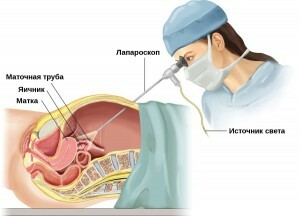
It is unlikely that someone will want to endure the anguish, which delivers the adhesive disease, treatment is required in all of its cases. But its choice depends on the stage of the disease and the arrangement of scars. Doing it yourself is not worth it, it's easy to make a mistake with the choice and even worse for yourself.
The specialist will choose between:
- Conservative therapy. It can help with adhesions caused by infection. Prescribe antibiotics, anti-inflammatory and analgesics, hormonal drugs. The latter normalize the menstruation for infections caused by infection. Restore the strength of vitamins and fortifying preparations;
- Fermentotherapy. Some types of connective tissue, if it is observed in a small amount, can be eliminated with preparations of the fibrinolytic group. This is Longidase, Trypsin, Chymotrypsin, Fibrinolysin. Medicines promote the resorption of scar tissue;
- Surgical methods. Spikes are dissected using a gentle laparoscopic intervention. The operation can be performed with a laser, an electron knife or spread the tissues with water jet under pressure. More often, such treatment is prescribed for acute disease;
- Physiotherapy. The method is used to help any of the listed if there is no inflammatory process. This is electrophoresis with zinc, calcium, magnesium and novocaine. The result of the treatment is more elastic spikes, and the monthly ones are less painful;
- Phytotherapy. Effective with small single spikes, but still requires medical supervision.
Prevention of adhesions
The disease sometimes has the property of returning. To avoid this, it is necessary to prevent adhesions, which includes:
- Control of immunity. It is necessary to take vitamins, supporting drugs that help the body prevent infection;
- Proper nutrition. It will save from problems with the intestines, and hence, increased gas formation and growth of scar tissue in the organ that is next to the small pelvis;
- Therapeutic physical training. The movement will ensure a normal blood supply to the reproductive organs, which will prevent a new formation of connective tissue;
- Timely treatment of diseases of the abdominal cavity and reproductive organs. The slightest cold, a cycle failure can cause a new appearance of adhesions;
- Examination at a gynecologist with regularity every six months.
Monthly with the already formed adhesions can be the first bell about the problems in the body. It is important to pay attention to this and take action on time. The ailment not only causes pain, inability to have full sex, but also pathologies such as bending of the uterus, tubal pregnancy, infertility.
